Your Ancestral Home
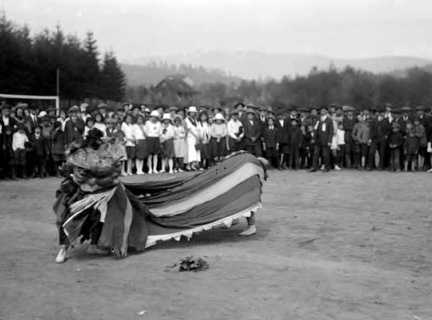
The majority of early emigrants from China to Canada came from the Pearl River Delta in southern China's Guangdong Province. This section provides more information about the Geography of Chinese Emigration including maps and information about the county origins of emigrants. It also offers tips on Locating Your Ancestral Home.
Geography of Chinese Emigration
A majority of early Chinese immigrants to Canada came from Guangdong Province in South China's Pearl River Delta. The emigrants came mainly from two districts in the province, San Yi (the Three Counties) and Si Yi (the Four Counties) as seen in the maps and table below. The provincial capital city, Guangzhou (Canton) was located in Panyu County, San Yi District.
|
Image
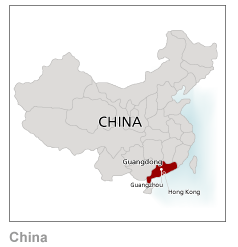
|
Image
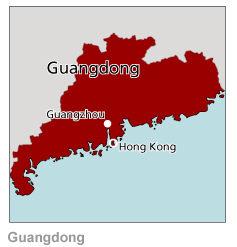
|
|
Image
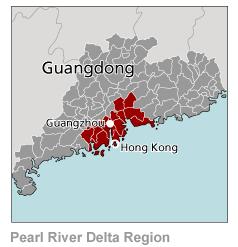
|
Image
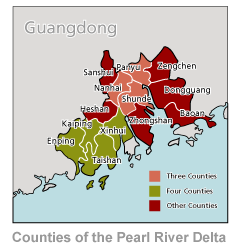
|
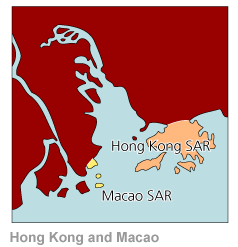
The table below lists the two districts and their constituent counties. There were also significant numbers of immigrants from counties in other districts. The Pinyin names are based on the preferred system used today to romanize Mandarin. However, people who lived in the Pearl River Delta spoke Cantonese. Due to dialectical variations, occurrences of county names in historical records may not always completely match the local Cantonese forms shown below. Moreover, attempts by Canadian immigration officials to record place names on documents such as head tax certificates may have produced results of questionable reliability. When examining place names associated with your family, therefore, do not expect absolute consistency in spelling and romanization.
| Pinyin Mandarin | Chinese characters | ||
| Traditional | Simplified | ||
| Province | Guangdong | 廣東 | 广东 |
| District | Si Yi | 四邑 | 四邑 |
| (4 Counties Group) | Xinhui | 新會 | 新会 |
| Kaiping | 開平 | 开平 | |
| Taishan | 臺山 | 台山 | |
| Enping | 恩平 | 恩平 | |
| District | San Yi | 三邑 | 三邑 |
| (3 Counties Group) | Nanhai | 南海 | 南海 |
| Panyu | 番禺 | 番禺 | |
| Shunde | 順德 | 顺德 | |
| Other Districts In addition to the counties situated in Si Yi and San Yi Districts, significant numbers of Chinese immigrants came from counties in other districts: |
|||
| Counties | Zhongshan | 中山 | 中山 |
| Baoan | 寶安 | 宝安 | |
| Zengcheng | 增城 | 增城 | |
| Dongguang | 東光 | 东光 | |
| Heshan | 鶴山 | 鹤山 | |
| Sanshui | 三水 | 三水 | |
For information on the geography of Chinese emigration, see:
Locating Your Ancestral Home
Chinese Immigration Certificates and Forms and Other Records of the Chief Controller of Chinese Immigration include the district and village of origin of Chinese immigrants to Canada.
However, even with these details, locating your ancestral village on a map may be challenging. As in the case of personal names, village names were frequently recorded idiosyncratically by Canadian immigration officials. Moreover, the construction of roads and factories, land reforms, and the establishment of communes under the communist government resulted in many changes to political and administrative land boundaries. In some cases, villages or hamlets were eliminated or put into groupings with others. This continued a tradition of rearranging and renaming local administrative units dating from imperial times.
The romanized spelling of the names has also resulted in changes to the names of villages. As well, the spelling of the names of Chinese villages has changed under the modern administration of the People's Republic of China (PRC). A further complication: some early 20th-century maps used place names based on a unique romanization system used by the Chinese post office of the time >— neither Wade-Giles nor Pinyin.
Tips
- Gather as many clues as you can regarding the location and name of your family's ancestral village. It may have been recorded on tombstones or in other sources. If possible, identify Chinese characters for the village's name.
- Speak to older relatives who may have heard or recall the name of the village. Ask them to write it down in Chinese characters if possible.
- Study maps of China and of Guangdong province so that you can ask the right questions and put new information into context.
The following online and print resources may be useful:
An Album of Chinese Maps
CHI 912.51 A34a
The International Map of the World
At a scale of 1:1,000,000. Includes maps of China. Sheets NF49, NG49, NF50 and NG50 cover Guangdong Province. These four map sheets are filed alphanumerically in Filing Cabinet Drawer 1.3 in the map area on Level 6 at the Central Library.
